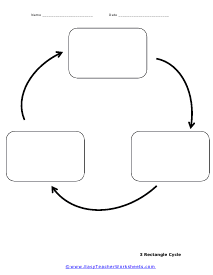Printable Cycle Charts
Click the buttons to print each organizer.

3 Circle Cycle
One, two, three, and back to one. Chart simple cycles with these blank circular templates.

3 Rounded Rectangle Cycle
One, two, three, and back to one. Chart simple cycles with these blank rectangular templates.

4 Circle Cycle
One extra step, but still a pretty easy sequence to follow. This template uses circles.

4 Rounded Rectangle Cycle
One extra step, but still a pretty easy sequence to follow. This template uses rectangles.


5 Rounded Rectangle Cycle
For five-stage cycles. Use these blank rectangles to make them easy to follow.

6 Circle Cycle
It's starting to get complicated, but these circular cycle templates keep it organized.

6 Rounded Rectangle Cycle
It's starting to get complicated, but these rectangular cycle templates keep it organized.

7 Circle Cycle
For tracking cycles with seven different elements, use these blank circles to make it clear.

7 Rounded Rectangle Cycle
For tracking cycles with seven different elements, use these blank rectangles to make it clear.
What are Cyclical Processes?
where you started, and the process starts again. Cyclical processes are perpetual. That means that they will continue indefinitely.
There are many cyclical processes like the water cycle or the carbon cycle. These cycles are vital for our survival. If we kept using up water the way we do and there was no water cycle to renew our supply, we would have finished all the earth's water long ago. Here's a deeper look into one of nature's cyclical processes, i.e., the water cycle.
As an Example: The Water Cycle
The water cycle has four steps:
- Evaporation
- Condensation
- Precipitation
- Collection
Each step plays a role in ensuring that we will always have water. We have been using the same water present since the beginning of life on the planet. It's hard to imagine, but we drink the same water that dinosaurs used to drink.
Evaporation
Evaporation is a constant process in which water molecules leave the water's surface to become water vapors. Evaporation happens faster when it is hotter outside and if the surface area of the water body is large. As a result, more water will evaporate from a hot bowl of soup than from a tall glass of water.
Even if both vessels have the same water, the bowl will lose more water faster. Evaporation is confused with boiling, but a simple way to tell them apart is that a bit of evaporation occurs at each temperature. At the same time, water only boils at a specific temperature.
Condensation
When all the water vapors in an area reach high in the sky where the temperature is much more relaxed, they turn back into a liquid. Drops of water attach themselves to pieces of dust or pollen in the sky, and from down here, we see big puffy clouds.
Precipitation
When the tiny drops of water join together and become too heavy to stay in the cloud, they start falling as rain droplets. Rainwater is relatively clean. If there were no air or water pollution, rainwater would be fit to drink.
In some places where the air is relatively pure, it is. If the temperature is cold enough, the rain droplets refreeze in the air and turn into snowflakes. Then we get to enjoy a snow day with our friends and family.
Collection
When the rain falls, the soil absorbs the water and helps the plants grow. Water also collects in large and small water bodies like lakes or puddles. Once the clouds move away and the sun comes out. With the sun back out, the heat it radiates starts the process of evaporation again.
Thus, the last step in the water cycle leads back to the first step, and the process continues cyclically. The other natural cyclical processes are essential as well. The oxygen cycle ensures we don't run out of oxygen to breathe. Similarly, the sulfur, carbon, and nitrogen cycles all play their role in maintaining our environment.
Cyclical processes can exist outside of nature. The mechanical operation of a heat engine is also a cyclical process. The process in which a refrigerator or an air conditioner works is the opposite of the cyclical process of a heat engine.
These are thermodynamic systems. That means they deal with temperature changes. These systems gain and lose temperature and accomplish some work. These are artificial cyclical processes that perform functions that help us in everyday tasks.

